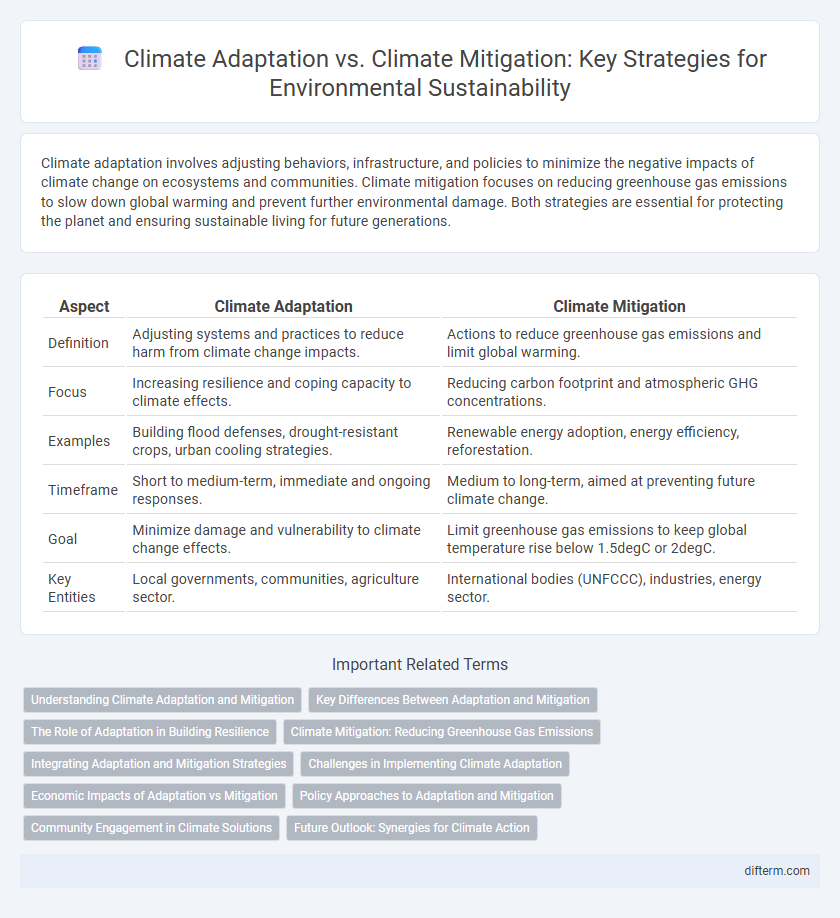Climate adaptation involves adjusting behaviors, infrastructure, and policies to minimize the negative impacts of climate change on ecosystems and communities. Climate mitigation focuses on reducing greenhouse gas emissions to slow down global warming and prevent further environmental damage. Both strategies are essential for protecting the planet and ensuring sustainable living for future generations.
Table of Comparison
| Aspect | Climate Adaptation | Climate Mitigation |
|---|---|---|
| Definition | Adjusting systems and practices to reduce harm from climate change impacts. | Actions to reduce greenhouse gas emissions and limit global warming. |
| Focus | Increasing resilience and coping capacity to climate effects. | Reducing carbon footprint and atmospheric GHG concentrations. |
| Examples | Building flood defenses, drought-resistant crops, urban cooling strategies. | Renewable energy adoption, energy efficiency, reforestation. |
| Timeframe | Short to medium-term, immediate and ongoing responses. | Medium to long-term, aimed at preventing future climate change. |
| Goal | Minimize damage and vulnerability to climate change effects. | Limit greenhouse gas emissions to keep global temperature rise below 1.5degC or 2degC. |
| Key Entities | Local governments, communities, agriculture sector. | International bodies (UNFCCC), industries, energy sector. |
Understanding Climate Adaptation and Mitigation
Climate adaptation involves adjusting natural or human systems in response to actual or expected climate impacts to reduce harm or exploit beneficial opportunities, such as building flood defenses or modifying agricultural practices. Climate mitigation focuses on reducing greenhouse gas emissions or enhancing carbon sinks to limit the magnitude of future climate change, including efforts like transitioning to renewable energy, improving energy efficiency, and reforestation. Understanding the distinction between adaptation and mitigation is critical for developing comprehensive climate strategies that address both immediate vulnerabilities and long-term emissions reduction.
Key Differences Between Adaptation and Mitigation
Climate adaptation involves adjusting natural or human systems in response to actual or expected climatic stimuli to minimize harm or exploit beneficial opportunities. Climate mitigation focuses on reducing or preventing the emission of greenhouse gases to limit the magnitude of future climate change. Key differences include adaptation addressing the impacts of climate change while mitigation targets the root causes by lowering carbon footprints.
The Role of Adaptation in Building Resilience
Climate adaptation plays a critical role in building resilience by enabling communities and ecosystems to adjust to current and projected climate impacts. Unlike climate mitigation, which focuses on reducing greenhouse gas emissions, adaptation strategies address vulnerabilities through infrastructure improvements, sustainable resource management, and disaster risk reduction. Implementing adaptive measures enhances the capacity to withstand extreme weather events, sea-level rise, and shifting agricultural conditions, thereby safeguarding livelihoods and biodiversity.
Climate Mitigation: Reducing Greenhouse Gas Emissions
Climate mitigation involves implementing strategies to reduce greenhouse gas emissions through renewable energy adoption, energy efficiency improvements, and reforestation projects. These efforts directly target the root causes of global warming by lowering carbon dioxide, methane, and nitrous oxide levels in the atmosphere. Effective climate mitigation policies can prevent severe climate impacts and support sustainable development goals worldwide.
Integrating Adaptation and Mitigation Strategies
Integrating climate adaptation and mitigation strategies enhances resilience and reduces greenhouse gas emissions simultaneously, creating synergies that maximize environmental benefits. For example, restoring wetlands not only sequesters carbon but also protects coastal areas from storm surges and flooding. Combining these approaches supports sustainable development goals by addressing immediate climate impacts and long-term emission reductions.
Challenges in Implementing Climate Adaptation
Challenges in implementing climate adaptation include limited financial resources, insufficient data for localized risk assessment, and institutional barriers that hinder policy integration. Moreover, uncertainty in climate projections complicates planning and prioritization of adaptive measures. Addressing these challenges requires enhanced collaboration between governments, communities, and technical experts to develop resilient and flexible adaptation strategies.
Economic Impacts of Adaptation vs Mitigation
Climate adaptation investments often yield immediate economic benefits by reducing vulnerability to extreme weather events, thereby minimizing damage and recovery costs. In contrast, climate mitigation typically involves higher upfront costs linked to transitioning energy systems but generates long-term savings through decreased carbon emissions and health-related expenses. Balancing adaptation and mitigation strategies is crucial for maximizing economic resilience and sustainable growth amid climate change challenges.
Policy Approaches to Adaptation and Mitigation
Policy approaches to climate adaptation prioritize enhancing community resilience through infrastructure upgrades, disaster risk management, and ecosystem-based solutions, ensuring systems withstand climate impacts. Climate mitigation policies focus on reducing greenhouse gas emissions via renewable energy adoption, carbon pricing mechanisms, and regulatory frameworks supporting energy efficiency. Integrating both approaches in national strategies enables balanced progress toward sustainable development and climate goals.
Community Engagement in Climate Solutions
Community engagement in climate solutions empowers local populations to identify vulnerabilities and co-develop adaptive strategies, enhancing resilience against climate impacts. In contrast, climate mitigation efforts often emphasize reducing greenhouse gas emissions through policy and technology, with community involvement driving behavioral shifts and support for sustainable initiatives. Integrating both approaches fosters inclusive participation, ensuring tailored responses that address immediate risks while contributing to long-term emission reduction goals.
Future Outlook: Synergies for Climate Action
Climate adaptation and climate mitigation strategies increasingly demonstrate synergies that enhance overall effectiveness in addressing global warming. Integrating adaptive measures such as resilient infrastructure with mitigation efforts like renewable energy deployment accelerates progress toward the Paris Agreement goals. Emerging technologies and policy frameworks emphasize this dual approach, optimizing resource allocation and maximizing climate resilience for future generations.
climate adaptation vs climate mitigation Infographic

 difterm.com
difterm.com